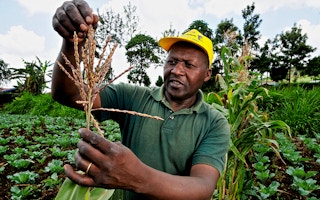Researchers have used mathematical modelling to develop techniques to combat two co-infecting viruses causing maize lethal necrosis (MLN) in Kenya.
According to researchers who conducted the new study, because maize is a staple crop in Sub-Saharan Africa, the spread of MLN is threatening food security in the region.
Nik Cunniffe, a co-author and a lecturer in mathematical biology at the UK-based University of Cambridge, says that the study’s objective was to test whether mathematical modelling could be used to make practical recommendations for disease control.
“This is important since MLN is a big problem, causing up to 90 per cent yield loss in heavily infected areas,” Cunniffe tells SciDev.Net, adding that MLN has been spreading in Kenya for the last six years, and has also been detected in Ethiopia, Rwanda and Tanzania.
“
We’ve developed a new framework to model co-infecting viruses, such as those causing MLN.
Nik Cunniffe, co-author and lecturer in mathematical biology, University of Cambridge
MLN usually arises from the interaction of two viruses: maize chlorotic mottle virus (MSMV) and sugarcane mosaic virus (SCMV).
The researchers from France, Germany, United Kingdom and the United Sates modelled the dynamics of SCMV and MCMV infection within and between maize growing periods, either during the long- or short-rain growing seasons. The model accounted for local virus transmission by vectors, through seeds, from infested soil and other sources, according to the study published this month (1 August) in the journal Phytopathology.
They then assessed control strategies for large and small farms under three scenarios: no management of disease, management without crop rotation and management with crop rotation.
“We’ve developed a new framework to model co-infecting viruses, such as those causing MLN, even when there’s not very much biological information available,” Cunniffe says.
The findings show that combining crop rotation, using virus-free seed, removing plants showing disease symptoms and controlling insect pests is the best way to control MLN.
But the control must be done synchronously over large areas because other diseases could repeatedly re-invade from outside the controlled area, Cunniffe adds.
“When two viruses infect a plant, they can interact with each other to cause much worse symptoms and greater losses of yield,” explains Cunniffe. “If you’re a subsistence farmer relying on income from the maize you’re growing, infection of the crop with MLN can be devastating.”
The researchers suggest that the model could provide practical information for key actors such as policymakers to control other crop diseases resulting from viral co-infection. But they also say that further studies are needed to help understand how co-infection of plants by the two viruses implicated in MLN affects seed and vector transmission.
James Karanja, an expert in MLN control at the Kenya Agriculture and Livestock Research Organization, says the study of scientific value.
“Its recommendations of farmers practising crop rotation are real and viable,” he says. “[But] it does not provide data on the gains from one season to the other, which will be key in selling the idea to the farmers.”
This piece was produced by SciDev.Net’s Sub-Saharan Africa English desk and was republished with permission.










